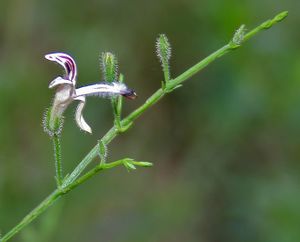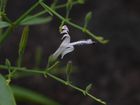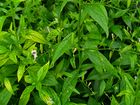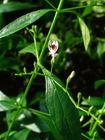Note: This is a project under development. The articles on this wiki are just being initiated and broadly incomplete. You can Help creating new pages.
Difference between revisions of "Andrographis paniculata - Kalmegh"
(→References) |
(→List of Ayurvedic medicine in which the herb is used) |
||
| (21 intermediate revisions by 2 users not shown) | |||
| Line 1: | Line 1: | ||
| − | |||
[[File:Andrographis paniculata (Kalpa) in Narshapur forest, AP W2 IMG 0867.jpg|thumb|right|''Kalmegh'', ''Andrographis paniculata'']] | [[File:Andrographis paniculata (Kalpa) in Narshapur forest, AP W2 IMG 0867.jpg|thumb|right|''Kalmegh'', ''Andrographis paniculata'']] | ||
[[File:469px-Andrographis paniculata Plant.JPG|thumb|right|''Kalamegha'', ''Nelabevu'']] | [[File:469px-Andrographis paniculata Plant.JPG|thumb|right|''Kalamegha'', ''Nelabevu'']] | ||
| − | + | '''Andrographis paniculata''' is an annual herbaceous plant in the family Acanthaceae, native to India and Sri Lanka.It is widely cultivated in Southern and Southeastern Asia, where it has been traditionally used to treat infections and some diseases. | |
==Uses== | ==Uses== | ||
| − | {{Uses| | + | {{Uses|Cancer}}, {{Uses|HIV}}, {{Uses|Cough}}, {{Uses|Cold}}, {{Uses|Sinusitis}}, {{Uses|Body pain}}, {{Uses|Liver problems}}, {{Uses|Leprosy}}, {{Uses|Cholera}} |
==Parts Used== | ==Parts Used== | ||
| Line 13: | Line 12: | ||
==Chemical Composition== | ==Chemical Composition== | ||
| − | Dihydroneobaicalein, andrographidine, andrographidine, andrographidine | + | Dihydroneobaicalein, andrographidine, andrographidine, andrographidine, dihydroxy, dimethoxyflavone, beta-D-glucopyranoside, three diterpenoids, andrograpanin, neoandrographolide ,andrographolide, two phenylpropanoids, trans-cinnamic acid and methoxycinnamaldehyde<ref name="chemical composition"/> |
==Common names== | ==Common names== | ||
| − | {{Common names|kn= | + | {{Common names|kn=Nelaberu, kaala megha|ml=Nelavepu, Kiriyattu|sa=Kalmegha, Bhunimba|ta=Nilavembu|te=Nilavembu|hi=Kirayat, Kalpanath|en=kariyat}} |
| + | |||
| + | ==Properties== | ||
| + | Reference: Dravya - Substance, Rasa - Taste, Guna - Qualities, Veerya - Potency, Vipaka - Post-digesion effect, Karma - Pharmacological activity, Prabhava - Therepeutics. | ||
| + | ===Dravya=== | ||
| + | |||
| + | ===Rasa=== | ||
| + | Tikta (Bitter) | ||
| + | ===Guna=== | ||
| + | Laghu (Light), Ruksha (Dry) | ||
| + | ===Veerya=== | ||
| + | Ushna (Hot) | ||
| + | ===Vipaka=== | ||
| + | Katu (Pungent) | ||
| + | ===Karma=== | ||
| + | Kapa, Pitta | ||
| + | ===Prabhava=== | ||
==Habit== | ==Habit== | ||
| Line 23: | Line 38: | ||
==Identification== | ==Identification== | ||
===Leaf=== | ===Leaf=== | ||
| − | {{Leaf|Simple| | + | {{Leaf|Simple|Opposite|9 x 1.5 cm, elliptic, acuminate at apex, base acute, decussate, glabrous.}}<ref name="Leaf"/> |
===Flower=== | ===Flower=== | ||
| − | {{Flower| | + | {{Flower|Bisexual|2-4cm long|White and purple|5-20|Panicle terminal and upper axillary, glandular-hairy; flowers many, distant. Calyx lobes 3 mm long, linear, hairy, connate at base, Corolla 14 mm long, pink or white with purple dots, tube ventricose, hairy, upper lip entire, midlobe of lower lip broader than laterals, acute, glandular-hairy. Ovary puberulous, style hairy.}} |
===Fruit=== | ===Fruit=== | ||
| − | {{Fruit|| | + | {{Fruit|Capsule|20-30 x 3 mm|oblong, acute, hairy; retinacula spoon shaped|eeds 8, glabrous|}} |
===Other features=== | ===Other features=== | ||
==List of Ayurvedic medicine in which the herb is used== | ==List of Ayurvedic medicine in which the herb is used== | ||
| − | * [[ | + | * [[Gopichandanadi gulika]] |
==Where to get the saplings== | ==Where to get the saplings== | ||
| Line 41: | Line 56: | ||
==How to plant/cultivate== | ==How to plant/cultivate== | ||
| − | In India, it is cultivated as rainy season (Kharif) crop. Any soil having fair amount of organic matter is suitable for commercial cultivation of this crop. About 400 gms. seed are sufficient for one hectare<ref name="How to plant/cultivate"/> | + | It can be easily raised through seed and vegetative methods. But in commercial cultivation, propagation through seed is easy and economical. In India, it is cultivated as rainy season (Kharif) crop. Any soil having fair amount of organic matter is suitable for commercial cultivation of this crop. About 400 gms. seed are sufficient for one hectare<ref name="How to plant/cultivate"/> |
==Commonly seen growing in areas== | ==Commonly seen growing in areas== | ||
| − | {{Commonly seen|Village groves}}, {{Commonly seen| | + | {{Commonly seen|Village groves}}, {{Commonly seen|Roadsides}}, {{Commonly seen|Waste places}}. |
==Photo Gallery== | ==Photo Gallery== | ||
<gallery class="left" caption="" widths="140px" heights="140px"> | <gallery class="left" caption="" widths="140px" heights="140px"> | ||
| − | + | 4677759790 d5fb6ee9e0 b.jpg|Whole plant | |
| − | + | 6256892648 f88fecd4f9 b.jpg|Flower | |
| − | + | Andrographis paniculata 001.JPG|Leaves | |
| + | Andrographis paniculata 002.JPG|Buds | ||
| + | File:Nilavepp (Malayalam- നിലവേപ്പ്) (6256601039).jpg|Capsules | ||
| + | |||
</gallery> | </gallery> | ||
| Line 56: | Line 74: | ||
<references> | <references> | ||
| − | <ref name="chemical composition">[https://www.ncbi.nlm.nih.gov/pubmed/21626787 | + | <ref name="chemical composition">[https://www.ncbi.nlm.nih.gov/pubmed/21626787 Chemical Constituents]</ref> |
| − | <ref name="Leaf">[ | + | <ref name="Leaf">[http://keralaplants.in/ Botanical description]</ref> |
| − | <ref name="How to plant/cultivate">[http:// | + | <ref name="How to plant/cultivate">[http://vikaspedia.in/agriculture/crop-production/package-of-practices/medicinal-and-aromatic-plants/andrographis-paniculata Cultivation]</ref> |
</references> | </references> | ||
==External Links== | ==External Links== | ||
| − | * [https://www.herbal-supplement-resource.com/andrographis-herb.html] | + | * [https://www.herbal-supplement-resource.com/andrographis-herb.html Andrographis – Health Benefits and Side Effects] |
| − | * [https://www.ncbi.nlm.nih.gov/pmc/articles/PMC4032030/] | + | * [https://www.ncbi.nlm.nih.gov/pmc/articles/PMC4032030/ Harnessing the medicinal properties of Andrographis paniculata] |
| − | * [https://www.bimbima.com/ayurveda/medicinal-use-of-kalmegh-andrographis-paniculata/1483/] | + | * [https://www.bimbima.com/ayurveda/medicinal-use-of-kalmegh-andrographis-paniculata/1483/ Medicinal Use Of Kalmegh] |
| − | * [https://www.omicsonline.org/open-access/andrographis-paniculata-a-review-of-its-traditional-uses-phytochemistry-and-pharmacology-2167-0412.1000169.php?aid=33645] | + | * [https://www.omicsonline.org/open-access/andrographis-paniculata-a-review-of-its-traditional-uses-phytochemistry-and-pharmacology-2167-0412.1000169.php?aid=33645 A Review of its Traditional Uses, Phytochemistry and Pharmacology] |
[[Category:Herbs]] | [[Category:Herbs]] | ||
| + | [[Category:Ayurvedic herbs that don't have seed photos]] | ||
| + | [[Category:Acanthaceae]] | ||
Latest revision as of 12:39, 3 June 2019
Andrographis paniculata is an annual herbaceous plant in the family Acanthaceae, native to India and Sri Lanka.It is widely cultivated in Southern and Southeastern Asia, where it has been traditionally used to treat infections and some diseases.
Contents
- 1 Uses
- 2 Parts Used
- 3 Chemical Composition
- 4 Common names
- 5 Properties
- 6 Habit
- 7 Identification
- 8 List of Ayurvedic medicine in which the herb is used
- 9 Where to get the saplings
- 10 Mode of Propagation
- 11 How to plant/cultivate
- 12 Commonly seen growing in areas
- 13 Photo Gallery
- 14 References
- 15 External Links
Uses
Cancer, HIV, Cough, Cold, Sinusitis, Body pain, Liver problems, Leprosy, Cholera
Parts Used
Chemical Composition
Dihydroneobaicalein, andrographidine, andrographidine, andrographidine, dihydroxy, dimethoxyflavone, beta-D-glucopyranoside, three diterpenoids, andrograpanin, neoandrographolide ,andrographolide, two phenylpropanoids, trans-cinnamic acid and methoxycinnamaldehyde[1]
Common names
| Language | Common name |
|---|---|
| Kannada | Nelaberu, kaala megha |
| Hindi | Kirayat, Kalpanath |
| Malayalam | Nelavepu, Kiriyattu |
| Tamil | Nilavembu |
| Telugu | Nilavembu |
| Marathi | NA |
| Gujarathi | NA |
| Punjabi | NA |
| Kashmiri | NA |
| Sanskrit | Kalmegha, Bhunimba |
| English | kariyat |
Properties
Reference: Dravya - Substance, Rasa - Taste, Guna - Qualities, Veerya - Potency, Vipaka - Post-digesion effect, Karma - Pharmacological activity, Prabhava - Therepeutics.
Dravya
Rasa
Tikta (Bitter)
Guna
Laghu (Light), Ruksha (Dry)
Veerya
Ushna (Hot)
Vipaka
Katu (Pungent)
Karma
Kapa, Pitta
Prabhava
Habit
Identification
Leaf
| Kind | Shape | Feature |
|---|---|---|
| Simple | Opposite | 9 x 1.5 cm, elliptic, acuminate at apex, base acute, decussate, glabrous. |
Flower
| Type | Size | Color and composition | Stamen | More information |
|---|---|---|---|---|
| Bisexual | 2-4cm long | White and purple | 5-20 | Panicle terminal and upper axillary, glandular-hairy; flowers many, distant. Calyx lobes 3 mm long, linear, hairy, connate at base, Corolla 14 mm long, pink or white with purple dots, tube ventricose, hairy, upper lip entire, midlobe of lower lip broader than laterals, acute, glandular-hairy. Ovary puberulous, style hairy. |
Fruit
| Type | Size | Mass | Appearance | Seeds | More information |
|---|---|---|---|---|---|
| Capsule | 20-30 x 3 mm | oblong, acute, hairy; retinacula spoon shaped | eeds 8, glabrous | {{{6}}} |
Other features
List of Ayurvedic medicine in which the herb is used
Where to get the saplings
Mode of Propagation
How to plant/cultivate
It can be easily raised through seed and vegetative methods. But in commercial cultivation, propagation through seed is easy and economical. In India, it is cultivated as rainy season (Kharif) crop. Any soil having fair amount of organic matter is suitable for commercial cultivation of this crop. About 400 gms. seed are sufficient for one hectare[3]
Commonly seen growing in areas
Village groves, Roadsides, Waste places.
Photo Gallery
References
External Links
- Ayurvedic Herbs known to be helpful to treat Cancer
- Ayurvedic Herbs known to be helpful to treat HIV
- Ayurvedic Herbs known to be helpful to treat Cough
- Ayurvedic Herbs known to be helpful to treat Cold
- Ayurvedic Herbs known to be helpful to treat Sinusitis
- Ayurvedic Herbs known to be helpful to treat Body pain
- Ayurvedic Herbs known to be helpful to treat Liver problems
- Ayurvedic Herbs known to be helpful to treat Leprosy
- Ayurvedic Herbs known to be helpful to treat Cholera
- Herbs with Leaves used in medicine
- Herbs with Whole herb used in medicine
- Herbs with common name in Kannada
- Herbs with common name in Hindi
- Herbs with common name in Malayalam
- Herbs with common name in Tamil
- Herbs with common name in Telugu
- Herbs with common name in Sanskrit
- Herbs with common name in English
- Habit - Herb
- Index of Plants which can be propagated by Seeds
- Index of Plants which can be propagated by Cuttings
- Herbs that are commonly seen in the region of Village groves
- Herbs that are commonly seen in the region of Roadsides
- Herbs that are commonly seen in the region of Waste places
- Herbs
- Ayurvedic herbs that don't have seed photos
- Acanthaceae






